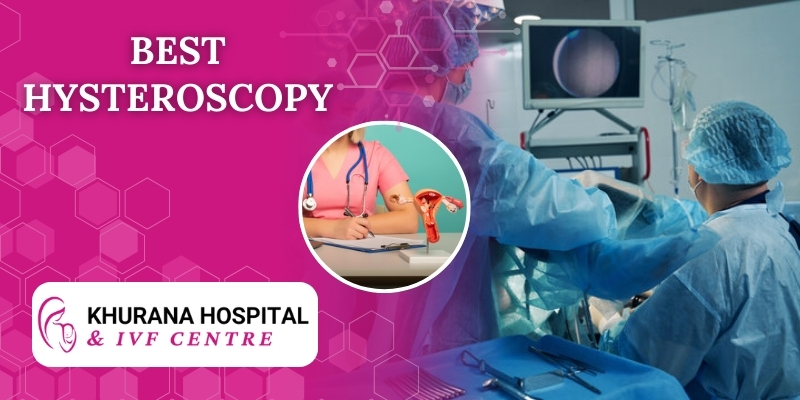Hysteroscopy
- Home
- Infertility Treatments
- Hysteroscopy

At Khurana Hospital and IVF Centre, we offer hysteroscopy, a minimally invasive surgical procedure used to examine the inside of the uterus. This procedure plays a crucial role in diagnosing and treating a variety of uterine conditions that can affect fertility, menstrual cycles, or overall reproductive health.
Hysteroscopy allows our specialists to visually inspect the uterus using a thin, lighted tube (called a hysteroscope), which is inserted through the cervix. This provides a clear view of the uterine lining and any abnormalities that may be present, such as polyps, fibroids, adhesions, or structural issues that could impact a woman’s health or fertility.
What is Hysteroscopy?
Hysteroscopy is a procedure that involves inserting a small, flexible tube with a camera (hysteroscope) into the uterus through the cervix. This allows the doctor to directly view the interior of the uterus on a monitor. The procedure can be used for both diagnostic and therapeutic purposes.
- Diagnostic Hysteroscopy: This involves the examination of the uterus to diagnose conditions such as fibroids, polyps, or abnormal bleeding patterns.
- Operative Hysteroscopy: If a condition is found, such as a polyp or fibroid, the same hysteroscope can be used to remove or treat the issue during the same procedure.
Why is Hysteroscopy Performed?
Hysteroscopy can be used for a variety of reasons, including:
- Investigation of Abnormal Bleeding: If you are experiencing irregular or heavy bleeding, a hysteroscopy can help identify the cause, such as fibroids, polyps, or endometrial issues.
- Diagnosis of Uterine Fibroids or Polyps: These are non-cancerous growths in the uterus that can cause pain, heavy bleeding, or fertility issues.
- Evaluation of Fertility Issues: Conditions like uterine scarring (Asherman’s syndrome), septum (a wall dividing the uterus), or fibroids can interfere with conception, and hysteroscopy helps diagnose and treat these issues.
- Evaluation of the Endometrial Lining: If a woman has had multiple miscarriages or difficulty becoming pregnant, hysteroscopy can evaluate the health of the uterine lining (endometrium).
- Removal of Uterine Abnormalities: If abnormalities such as fibroids, polyps, or adhesions are discovered, operative hysteroscopy allows the surgeon to remove or correct the issues immediately.
- Sterilization Procedure (Essure): Hysteroscopy can be used for certain permanent birth control methods, such as inserting coils to block the fallopian tubes (Essure).
The Hysteroscopy Procedure
The procedure is generally performed in an outpatient setting, meaning it typically does not require an overnight stay. Here is what you can expect during the procedure:
- Preparation: You may be given a mild sedative to relax you before the procedure. In some cases, local anesthesia is used, but in more complex cases, general anesthesia might be recommended.
- Procedure: The hysteroscope is gently inserted into the uterus through the cervix, and the uterus is filled with a sterile solution (saline or carbon dioxide) to help provide a clearer view.
- Examination and Treatment: The doctor will carefully examine the uterine cavity, and if necessary, perform treatments such as removing polyps, fibroids, or scar tissue, or correcting structural abnormalities.
- Post-Procedure Care: After the procedure, you may experience mild cramping or spotting, which is normal. Most patients are able to resume normal activities within a day or two, depending on the complexity of the procedure.
Benefits of Hysteroscopy
- Minimally Invasive: Hysteroscopy is minimally invasive, meaning there are small incisions, and recovery times are generally quicker compared to traditional surgery.
- Accurate Diagnosis: It provides direct visualization of the inside of the uterus, allowing for accurate diagnosis of various uterine conditions.
- Treatment in One Procedure: If any abnormalities are found during diagnostic hysteroscopy, they can often be treated immediately during the same procedure, saving time and reducing the need for multiple treatments.
- Improved Fertility: For women experiencing fertility issues, hysteroscopy can help diagnose and treat uterine conditions that may be hindering conception, improving the chances of successful pregnancy.
- Quick Recovery: The recovery time for hysteroscopy is generally short, with many patients returning to normal activities within a few days, depending on the nature of the procedure.
